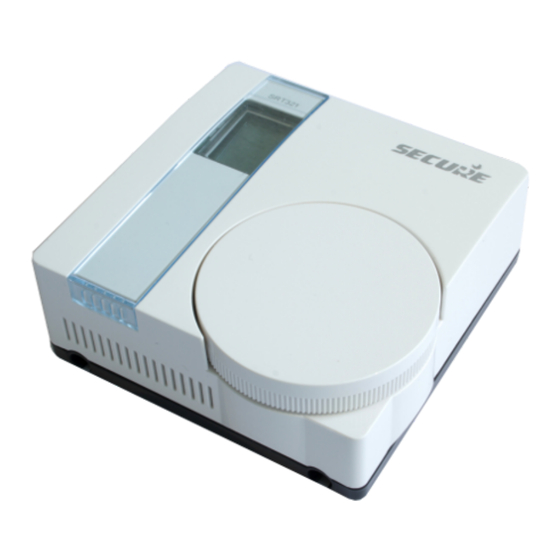
Table of Contents
Advertisement
Quick Links
SEC_SRT321
Wall Thermostat with LCD display
Firmware Version : 2.0
Quick Start
A
This is a wireless Actor. For Inclusion of Z-Wave devices into the thermostats network do the following steps:
Set DIL switch 1 on the back of the unit to 'ON' position, scroll through the function menu by rotating the dial, select
"I" to include nodes into the network or "E" to exclude a node from network. For including the SRT321 as a
secondary controller into an existing the Z-Wave network do the following steps: Set DIL switch 1 on the back of the
unit to 'ON' position, scroll through the function menu by rotating the dial, select "L".
Please refer to the chapters below for detailed information about all aspects of the products usage.
What is Z-Wave?
This device is equipped with wireless communication complying to the Z-Wave standard. Z-Wave is the
inte rnational standard for w ire le ss com m unication in smart homes and buildings. It is using the fre que ncy
of 868.42 MHz to realize a very stable and secure communication. Each message is reconfirmed (tw o-w ay
com m unication) and every mains powered node can act as a repeater for other nodes (m e she d ne tw ork) in case
the receiver is not in direct wireless range of the transmitter.
Z-Wave differentiates between Controllers and Slaves. Slaves are either sensors (S) transmitting metered or
measured data or actuators (A) capable to execute an action. Controllers are either static mains powered controllers
(C) also referred to as gateways or mobile battery operated remote controls (R). This results in a number of possible
communication patterns within a Z-Wave network that are partly or completely supported by a specific device.
1. Controllers control actuators
2. Actuators report change of status back to controller
3. Sensors report change of status of measured values to
controller
4. Sensors directly control actuators
5. Actuators control other actuators
6. Remote controls send signals to static controllers to trigger
scenes or other actions
7. Remote controls control other actuators.
There are two different role a controller can have. There is always one single primary controller that is managing the network and
including/excluding devices. The controller may have other functions - like control buttons - as well. All other controllers don't
manage the network itself but can control other devices. They are called secondary controllers. The image also shows that its not
possible to operate a sensor just from a remote control. Sensors only communicate with static controllers.
Advertisement
Table of Contents

Subscribe to Our Youtube Channel
Summary of Contents for Secure SEC_SRT321
-
Page 1: Quick Start
It is using the fre que ncy of 868.42 MHz to realize a very stable and secure communication. Each message is reconfirmed (tw o-w ay com m unication) and every mains powered node can act as a repeater for other nodes (m e she d ne tw ork) in case the receiver is not in direct wireless range of the transmitter. -
Page 2: Product Description
Offer the plate to the wall in the position where the SRT321 is to be mounted and mark the fixing positions through the slots in the wall plate. Drill and plug the wall, then secure the plate into position. The slots in the wall plate will compensate for any misalignment of the fixings. -
Page 3: Behavior Within The Z-Wave Network
Behavior within the Z-Wave network On factory default the device does not belong to any Z-Wave network. The device needs to join an existing wireless network to communicate with the devices of this network. This process is called Inclusion. Devices can also leave a network. This process is called Exclusion. Both processes are initiated by the primary controller of the Z-Wave network. -
Page 4: Wakeup Intervals - How To Communicate With The Device
once: I Include Node onto network E Exclude Node from network N Transmit Node Information Frame (NIF) L Learn Mode - use this command for Include or Exclude with another controller (does not support control group replication) Inclusion and reception of a primary role (Controller Shift) Li Receive Period Enabled (Listening). - Page 5 respective association group will receive a common wireless command. Association Groups: Nodes controlled by Thermostat Node Set command (max. nodes in group: 4) Nodes controlled by Binary Switch SET command (max. nodes in group: 1) Nodes to receive unsolicited Battery Level Reports (max. nodes in group: 1) Nodes to receive Thermostat Set Point Reports (max.
-
Page 6: Reset The Controller
The primary controller can exclude devices from the Z-Wave network. During exclusion the relationship between the device and the network of this controller is terminated. No communication between the device and other devices still in the network can happen after a successful exclusion. The controller needs to be turned into the exclusion mode. -
Page 7: Command Classes
Value D e scription 0 — 127 Disable (Default 0) 255 — 128 Enabled Te m pe rature Scale (Param e te r Num be r 2, Param e te r Size 1) Sensor will report temperature in this scale Value D e scription 0 —... -
Page 8: Explanation Of Z-Wave Specific Terms
Battery Type 2 * AAA Explorer Frame Support 5.02 pl3 Device Type Portable controller Generic Device Class Thermostat Specific Device Class Specific Device Class not used Routing FLiRS Firmware Version Explanation of Z-Wave specific terms Controlle r — is a Z-Wave device with capabilities to manage the network. Controllers are typically Gateways, Remote Controls or battery operated wall controllers.
















Need help?
Do you have a question about the SEC_SRT321 and is the answer not in the manual?
Questions and answers